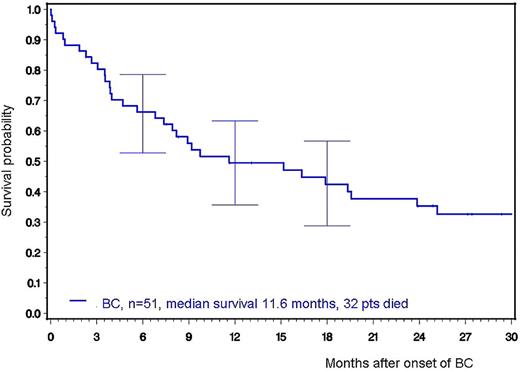Abstract
Abstract 3287
Poster Board III-1
Blast crisis (BC) in CML in the imatinib era is a rare event with 1–3% of newly diagnosed BC patients per year in the IRIS study, but prognosis, once BC has occurred, remains poor. Historical and recent studies with imatinib and second generation tyrosine kinase inhibitors (TKI) reported a median survival time of 7–10 months and two year survival probabilities of <30%. In order to recognize earlier time points for intervention we aimed to characterize the evolution to BC in the imatinib era using the prospective randomized German CML study IV which compares imatinib based strategies in chronic phase CML. By July 2009, BC was observed in 51 patients (pts) out of 1347 randomized pts (3.8%), with equal distribution amongst the treatment arms. 36 pts (67%) were male. 21 pts (41%) had myeloblastic, 16 pts (31%) lymphatic, 2 pts (4%) biphenotypic, and 2 pts (4%) megakaryoblastic BC; 10 pts (20%) were not classifiable. At diagnosis of CML, 23 pts (45%) had low, 17 intermediate (33%) and 11 high risk (22%) according to the Euro score (proportion of low risk in pts without BC was 34%). Median age at diagnosis was younger for male pts (41 years; range 18–79) than for female pts (57 years; range 19–77). Median time from diagnosis to onset of BC was 11.3 months (range 0.7–71). Prior to BC, all pts had received imatinib except one who received interferon alpha (IFN) and dasatinib. Two pts had received an allogeneic stem cell transplantation (alloSCT) and four a second generation TKI before diagnosis of BC. The BC rates per year comparing CML studies IV and IIIA (IFN based treatment vs. alloSCT) are shown in the Table. The probabilities to survive without BC are almost identical in both studies for year 1, but are higher in CML study IV afterwards. During CP, all pts were evaluable for hematologic, 44 for cytogenetic and 46 for molecular response to initial therapy. 29 pts (57%) had achieved a complete hematologic, 9 (20%) complete, 3 (7%) major cytogenetic and 4 (9%) major molecular remissions. Cytogenetics at diagnosis of CML were available for 47 BC pts: 29 pts (62%) had a t(9;22) translocation only and 18 (38%) additional chromosomal aberrations (ACA; variant Philadelphia chromosome n=5, complex aberrant karyotype n=9, other n=4) (for comparison: ACAs at diagnosis were detected in 95 of 1,095 pts (9%) without BC). Cytogenetics at onset of BC were available for 29 pts: 7 pts (24%) had a t(9;22) translocation only and 22 pts (76%) ACAs (complex n=13, other n=9). 17 (10 different) BCR-ABL mutations (8 P-loop including 5 E255V/K; 2 M244V; 2 T315I; 2 F317L and 3 others) were detected in 14 of 33 pts (42%). Median follow-up after BC was 34 months (range 2.3–53). 24 patients were transplanted, 10 pts were treated with second generation TKI (dasatinib n=9, nilotinib n=1), 4 of these were also transplanted, 16 received other therapies (imatinib dose escalation in combination with chemotherapy n=7, chemotherapy alone n=9), one no therapy. 32 pts died. Only 19 of the 51 pts (37%) were alive, 16 of them (84%) after allogeneic HSCT. 2 pts are alive on second generation TKI and one on busulfan. Median survival after BC was 11.6 months, survival probability at two years was 35% (s. Figure).
BC occurred early after diagnosis, in a high proportion of low risk patients. There was a preponderance of young males, and a high proportion with ACA at diagnosis. The best chances for survival were by alloHSCT. The short median time to BC indicates that evolution to BCR-ABL independence may have occurred already prior to CML diagnosis and start of imatinib therapy. Early identification and rapid initiation of a donor search in patients with early failed response to imatinib is warranted.
| . | Progression to BC and survival . | |||||
|---|---|---|---|---|---|---|
| . | BC rate per year . | |||||
| Year . | 1 . | 2 . | 3 . | 4 . | 5 . | 6 . |
| CML Study IV | 2.3% | 1.5% | 0.5% | 0.6% | 0.3% | 1.1% |
| CML Study IIIA | 3.3% | 3.7% | 1.5% | 1.7% | 1.2% | 1.0% |
| Survival probability without BC | ||||||
| CML Study IV | 98% | 96% | 96% | 95% | 95% | 94% |
| CML Study IIIA | 97% | 93% | 91% | 90% | 89% | 88% |
| . | Progression to BC and survival . | |||||
|---|---|---|---|---|---|---|
| . | BC rate per year . | |||||
| Year . | 1 . | 2 . | 3 . | 4 . | 5 . | 6 . |
| CML Study IV | 2.3% | 1.5% | 0.5% | 0.6% | 0.3% | 1.1% |
| CML Study IIIA | 3.3% | 3.7% | 1.5% | 1.7% | 1.2% | 1.0% |
| Survival probability without BC | ||||||
| CML Study IV | 98% | 96% | 96% | 95% | 95% | 94% |
| CML Study IIIA | 97% | 93% | 91% | 90% | 89% | 88% |
Survival of BC patients after treatment with imatinib; data of the German CML Study IV
Survival of BC patients after treatment with imatinib; data of the German CML Study IV
German CML Study Group:Deutsche Krebshilfe: Research Funding; Novartis: Research Funding; German CompetenceNet : Research Funding; European LeukemiaNet: Research Funding; Roche: Research Funding; Essex: Research Funding.
Author notes
Asterisk with author names denotes non-ASH members.


This feature is available to Subscribers Only
Sign In or Create an Account Close Modal